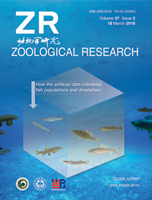
|
Zoological Research
Kunming Institute of Zoology, Chinese Academy of Sciences
ISSN: 2095-8137
Vol. 38, No. 3, 2017, pp. 155-162
|
 Bioline Code: zr17020
Bioline Code: zr17020
Full paper language: English
Document type: Research Article
Document available free of charge
|
|
|
Zoological Research, Vol. 38, No. 3, 2017, pp. 155-162
| zh |
GCH1基因在藏族高原适应中发挥作用
Guo, Yong-Bo; He, Yao-Xi; Cui, Chao-Ying; Ouzhuluobu; Baimakangzhuo; Duojizhuoma; Dejiquzong; Bianba; Peng, Yi; Bai, Cai-juan; Gonggalanzi; Pan, Yong-Yue; Qula; Kangmin; Cirenyangji; Baimayangji; Guo, Wei; Yangla; Zhang, Hui; Zhang, Xiao-Ming; Zheng, Wang-Shan; Xu, Shu-Hua; Chen, Hua; Zhao, Sheng-Guo; Cai, Yuan; Liu, Shi-Ming; Wu, Tian-Yi; Qi, Xue-Bin & Su, Bing
藏族人群能很好地适应高原低氧环境。以前的全基因组扫描研究已经报道了众多低氧适应的候选基因,但只有少数几个基因被研究过。有鉴于此,我们研究了低氧适应候选基因GCH1(GTP-环化水解酶I型)在藏族高原低氧适应中的作用。该基因主要参与维持一氧化氮合酶(NOS)的功能及血压的调节,在藏族群体中存在许多潜在的适应性序列变异。我们在50个无亲缘关系的藏族个体中完成了覆盖GCH1基因60.8kb及其上下游各10kb非编码区域的重测序。结合之前发表的数据,我们验证了GCH1基因中存在很多在高原藏族和平原汉族群体之间具有明显遗传分化的多态位点。通过中性检验我们进一步确认GCH1基因在藏族群体中存在达尔文正选择信号。此外,遗传相关性分析的结果表明,藏族群体GCH1基因适应性突变与多个生理性状显著相关,包括血液一氧化氮浓度、血氧饱和度及血红蛋白浓度。综合上述证据,我们认为GCH1基因在藏族高原低氧遗传适应中发挥重要作用。
GCH1; 选择信号; 藏族; 低氧适应; 一氧化氮; 血氧饱和度; 血红蛋白
|
| |
| en |
GCH1 plays a role in the high-altitude adaptation of Tibetans
Guo, Yong-Bo; He, Yao-Xi; Cui, Chao-Ying; Ouzhuluobu; Baimakangzhuo; Duojizhuoma; Dejiquzong; Bianba; Peng, Yi; Bai, Cai-juan; Gonggalanzi; Pan, Yong-Yue; Qula; Kangmin; Cirenyangji; Baimayangji; Guo, Wei; Yangla; Zhang, Hui; Zhang, Xiao-Ming; Zheng, Wang-Shan; Xu, Shu-Hua; Chen, Hua; Zhao, Sheng-Guo; Cai, Yuan; Liu, Shi-Ming; Wu, Tian-Yi; Qi, Xue-Bin & Su, Bing
Abstract
Tibetans are well adapted to high-altitude hypoxia. Previous genome-wide scans have reported many candidate genes for this adaptation, but only a few have been studied. Here we report on a hypoxia gene (GCH1, GTP-cyclohydrolase I), involved in maintaining nitric oxide synthetase (NOS) function and normal blood pressure, that harbors many potentially adaptive variants in Tibetans. We resequenced an 80.8 kb fragment covering the entire gene region of GCH1 in 50 unrelated Tibetans. Combined with previously published data, we demonstrated many GCH1 variants showing deep divergence between highlander Tibetans and lowlander Han Chinese. Neutrality tests confirmed a signal of positive Darwinian selection on GCH1 in Tibetans. Moreover, association analysis indicated that the Tibetan version of GCH1 was significantly associated with multiple physiological traits in Tibetans, including blood nitric oxide concentration, blood oxygen saturation, and hemoglobin concentration. Taken together, we propose that GCH1 plays a role in the genetic adaptation of Tibetans to high altitude hypoxia.
|
| |
© Copyright 2017 - Editorial Office of ZOOLOGICAL RESEARCH
Alternative site location: http://www.zoores.ac.cn/
|
|
